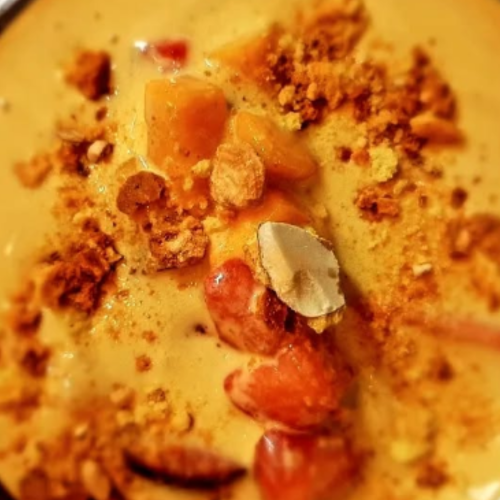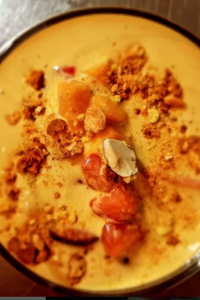Method
Step 1: Prepare Your Double Boiler
Place a heatproof bowl over a pot of simmering water (this is your double boiler setup). Make sure the water is simmering, not boiling, as the eggs need to be gently cooked.
Step 2: Whisk the Egg Yolks and Sugar
In the heatproof bowl, combine the egg yolks and sugar. Whisk them together until the mixture is smooth and slightly pale in color. This will create the base for your zabaglione.
Step 3: Add the Wine
Slowly pour the Marsala wine into the egg mixture while whisking constantly. It’s important to do this slowly so the eggs don’t cook too quickly and scramble.
Step 4: Cook Over Simmering Water
Continue whisking the egg mixture over the simmering water for about 10 minutes. The zabaglione should thicken to a creamy consistency. Keep whisking to ensure the mixture doesn’t curdle. It’s done when it’s thick enough to hold a ribbon-like trail when the whisk is lifted.
Step 5: Serve Immediately
Once it’s ready, remove the bowl from the heat. You can serve it warm in individual glasses or bowls. Optionally, add a dollop of whipped cream or fresh berries for garnish.
Variations
Chocolate Zabaglione: Add a tablespoon of cocoa powder or melted chocolate to the egg mixture for a rich twist.
Fruit Pairing: Serve your zabaglione with fresh berries or roasted peaches for a refreshing contrast.
Non-Alcoholic Version: If you prefer a non-alcoholic option, replace the Marsala wine with fruit juice (grape or apple juice works well).
Tips and Substitutions
Wine Substitution: If you don’t have Marsala wine, try using other sweet wines like Madeira or sherry. For a less traditional but still tasty option, you can substitute with a sweet fruit juice or even a flavored syrup.
Eggs: Fresh eggs are key to making zabaglione. Using pasteurized eggs is a safer option if you're concerned about raw eggs.
Consistency: If your zabaglione is too runny, whisk it longer over the heat until it thickens. If it’s too thick, add a little more wine to loosen it up.

